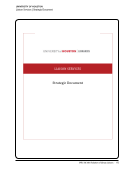86 · Survey Results: Survey Questions and Responses
Conducted user surveys 20 63%
Interviewed members of department(s) 12 38%
Tracked number of department meetings attended by liaisons 9 28%
Conducted focus groups 9 28%
Other evaluation method 9 28%
Please briefly describe the other evaluation method. N=9
April 2015 external review: reviewers held confidential meetings with over 50 senior leaders and administrators across
the university about how the library engages with faculty.
Data from accreditation studies, data from 3rd party survey instruments, coordination with grant rates/patient care
outcomes/student success
Department meetings attended is an optional statistic.
Developed a matrix and used self-reported scoring to measure liaison engagement with departments.
How well is the liaison integrated into their assigned units—committees, teams, workgroups, projects. Note that the
willingness of the unit to work with the liaison is also considered (no matter how good the liaison, some units just refuse
to play).
More is not necessarily better, quality of interactions and strategic impact are valued greatly.
On a couple occasions, a library school student has done a paper or report for the library. In one example, a student
interviewed each of the liaisons and conducted a focus group session and provided a detailed report in which the
information was de-identified. This provided data on how much time liaisons estimated they spent on those activities,
how much time spent learning domain subject knowledge, the types of services they felt their groups most valued, and
similar information.
Review of evaluations from instruction sessions and/or workshops
Would like to use new methods soon.
Additional Comments N=2
Although we trace the number of instruction sessions, reference interviews, department meetings, I’d say that we have
not used these for formal evaluation of liaison services. We have not articulated desired outcomes or evaluated the
effectiveness of our services. We have conducted LibQUAL+®, but it has been some time ago.
We don’t look at any of these measures on a systematic basis, but do occasionally observe some of these trends in
our data.
40. Please identify indicators of success for your library’s liaison program. Check all that apply. N=61
New partnerships across campus 58 95%
Increased number of consultations 52 85%
Increased number of classes 49 80%
Recognition from library and other professional organizations 24 39%
Conducted user surveys 20 63%
Interviewed members of department(s) 12 38%
Tracked number of department meetings attended by liaisons 9 28%
Conducted focus groups 9 28%
Other evaluation method 9 28%
Please briefly describe the other evaluation method. N=9
April 2015 external review: reviewers held confidential meetings with over 50 senior leaders and administrators across
the university about how the library engages with faculty.
Data from accreditation studies, data from 3rd party survey instruments, coordination with grant rates/patient care
outcomes/student success
Department meetings attended is an optional statistic.
Developed a matrix and used self-reported scoring to measure liaison engagement with departments.
How well is the liaison integrated into their assigned units—committees, teams, workgroups, projects. Note that the
willingness of the unit to work with the liaison is also considered (no matter how good the liaison, some units just refuse
to play).
More is not necessarily better, quality of interactions and strategic impact are valued greatly.
On a couple occasions, a library school student has done a paper or report for the library. In one example, a student
interviewed each of the liaisons and conducted a focus group session and provided a detailed report in which the
information was de-identified. This provided data on how much time liaisons estimated they spent on those activities,
how much time spent learning domain subject knowledge, the types of services they felt their groups most valued, and
similar information.
Review of evaluations from instruction sessions and/or workshops
Would like to use new methods soon.
Additional Comments N=2
Although we trace the number of instruction sessions, reference interviews, department meetings, I’d say that we have
not used these for formal evaluation of liaison services. We have not articulated desired outcomes or evaluated the
effectiveness of our services. We have conducted LibQUAL+®, but it has been some time ago.
We don’t look at any of these measures on a systematic basis, but do occasionally observe some of these trends in
our data.
40. Please identify indicators of success for your library’s liaison program. Check all that apply. N=61
New partnerships across campus 58 95%
Increased number of consultations 52 85%
Increased number of classes 49 80%
Recognition from library and other professional organizations 24 39%












































































































































































































